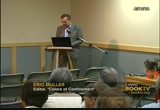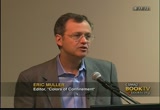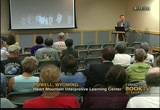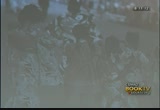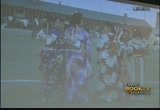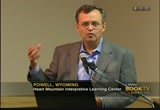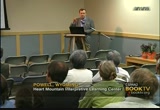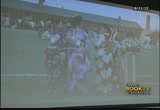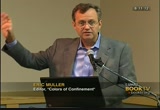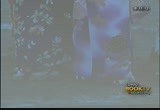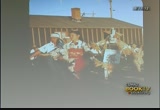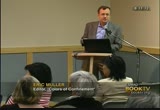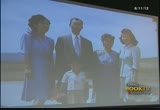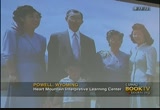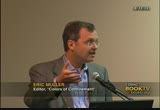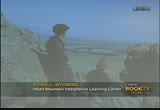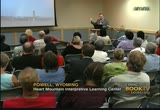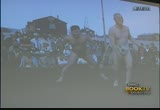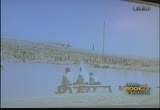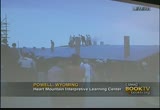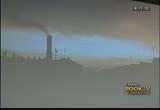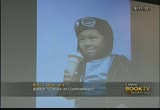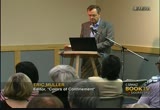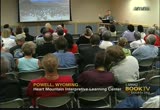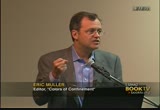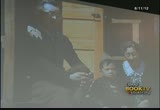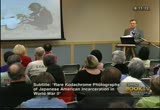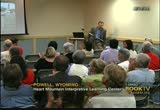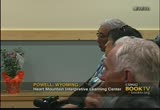tv Book TV CSPAN September 3, 2012 7:00pm-8:00pm EDT
7:00 pm
7:01 pm
you might try picturing a burning u.s. warship at pearl harbor. or if you'd rather do a happier image, how about a man kissing a woman, leaning over and kissing a woman in times square in new york on victory day. or maybe you prefer politics. how about churchill, stalin and roosevelt at yalta is sitting down together. maybe that manage. or maybe you'd rather think of something from the america of that era roughly. maybe a little bit earlier. the great depression. try to get an image in your mind of the great depression. if you're having trouble, think of a tired, worried looking young mother staring off into the distance with the ragamuffin child leaning on each shoulder.
7:02 pm
can you find that famous iconic image in your mind? the iconic photographs that we've come to call my grandmother that have come to symbolize the great depression. it's very likely as i've done this with you just now that the images you conjured up beneath mine have been in black and white. very, very likely. so now i'd like you to do the same exercise, but thinking about world war ii. try to find an image that represents the imprisonment of japanese americans during the war. so what are you picturing? to look like this? a bunch of young, japanese-american gross income on those dance scene. this is a photograph taken by a government photographer at the
7:03 pm
granada relocation center, also known as ahmad sheikh in eastern colorado in august 1943. so if this is what you had in mind, what's different about it? well, it's a photo as a set of young american citizens dancing, celebrating their ancestors in the summertime buddhist ritual called john dory. does it surprise you that japanese americans would have engaged in such open displays of japanese culture while detained but was basically a prison camp? maybe wasn't so open because after all it was that night. this is happening at night, so there's a surreptitious quality to this. well, this is a photograph above are dory here at heart mountain and was taken either in july of 1943 or july 1944.
7:04 pm
we can't be sure which. one or the other. it's daytime. nothing suspicious about it, nothing surreptitious about it. the baruch in the background you can see is taking place in an open public space within the residential area of the camp itself. let's check this image out. there we go. so there something else special about this image. it's in color. it's actually a brilliant beautiful color. take this photograph and for a moment. it's another shot at the same event at heart mountain and he was taken up by a government photographer, but one of the attorneys in camp. so just check that out. look at that. but the color restored.
7:05 pm
i've taken color photographs and i've removed the color so you can see the way we are accustomed to seeing it there and then you can see it the way we shop by the photographer. so i want to take a moment and ask you what the impact it's had that deer a couple comments you. what is the impact of this historical moment in color rather than in black and white. a couple of you could maybe put into words what the difference might eat at seeing it in color is supposed to black and white? >> i know when i saw the color come up and felt warm to me. >> any other reactions. >> the color seems a little more present time.
7:06 pm
>> there's something about black and white when you're looking at an historical photograph come as something seemed black-and-white to market in history, where is the color makes it feel a little more current. any other suggestions? yes, ma'am. i am back >> very interesting. because you're feeling of happiness and everything is fine. >> when it's in black cloaks black-and-white. it looks kind of dangerous. >> dangerous, somber. >> stark versus real. >> spontaneous versus staged. definitely the black-and-white propaganda image is replaced by something that seems authentic and is not that moment.
7:07 pm
>> wonderful suggestion. let's hold onto these because they think it's an important theme of this project, this hook called "colors of confinement" of which this is the presentation is to think about not just the episode that were treating the incarceration during world war ii, but also the way we interact with it, the way we see it in the way these representations communicate meaning to ask. so let me say a few things -- i want to volunteer a few of my own observations of what is striking about this photograph. one of them is just the beauty of the subjects. the beauty of the subjects and i'm not just talking about there, notice, which are gorgeous. i'm talking about their energy. there is a beautiful energy to these young women. there is a light and humor. the lighting is not perfect, but the woman in the red, know what the flowers, the white flowers is turned to the left and a lack
7:08 pm
of what can only be described as a gleeful amusement. obviously something very funny has just been sat on this photograph was snapped in this group of young women. so let's spend a moment on that. there's a playfulness in the interaction to this group. this is unusual. but we are accustomed to seeing his images of dreariness, images bleakness, depictions that on their surface communicate and justice. if you are familiar with that, a toy to miyazaki's very famous photograph of three boys that man's unarmed, standing and looking across wistfully across the barbed wire fence. a black-and-white image. that is the classic image of incarceration. this is something quite
7:09 pm
different. notice the contrast between the beauty of the subject and the bleakness of the backdrop, to try, parched ground that they are standing on, the jury tarpaper barracks that they lived in, the chimney of the communal mess hall where they eat their meals. notice again something i suggested in the earlier photograph, and the black-and-white one, the openness of japanese culture. this is something we're very unaccustomed to in the imagery of this era. and this is hard to see in this light, don't miss -- look at the young lady in the purple to the left of the women who's laughing, smiling and she's wearing battle shoes. you put down at the bottom. she's got unsubtle shoes. so this is not a depiction only of japanese culture. there is something called shirley complicated going on
7:10 pm
here, given the ages of the subjects, we can be certain that if we could listen in on their conversation, they would be speaking unaccented american english. so there is something culturally complicated being documented here. i love this photograph. this one shows that cultural blend that i'm talking about in a really beautiful and humorous way. same event. dibona dorie summertime buddhist ritual of celebration of urged. and we've got a young woman dancing into a racial or committeemen head and dancing. and over the left shoulder to someone, a man or woman who is stressed him or herself up as some kind of fanciful bird or dragon. ndc would be used to make the costume? they used cereal boxes from the mess hall kitchen, the white
7:11 pm
plates in front is a race krispies box. and the one above it is the one who is not survive. something called we go next. does anyone remember? there's actually layers of cultural complexity here because you've got a japanese-american dancer engaging in a japanese dance in an american prison camp, making a costume out of boxes of american serials and the american serials that they chose of course his race krispies, which is a concoction based on staple of the japanese diet, race. so there's one other thing about this photograph that is a little surprising kaman besides the fact they were in color, despite the fact they showed japanese
7:12 pm
cultural activities rather than american cultural activities. but i want to give you a hint. there's something a little bit startling about the photograph. any ideas of what i might be referring to? [inaudible] >> exactly. the thing i'm alluding to is what is outside is a photographer. somebody was taking this photograph with a camera and he was a japanese-american prisoner at this camp. so that is worth noting, too. we are usually led to believe and do history at certain points the cameras were contraband. so why would a japanese-american have had a camera?
7:13 pm
and why would he have felt comfortable shooting a photograph out in the open like this under the guise of the camp administration? well off a little more about that later. for right now remember, somebody's taken these photographs and remember, there's a lot more going on in this place of confinement than what she see in these photographs. the photographs are a snapshot of a subject. there's an entire world surrounding that subject. so what are they to do with you for a little while today to share with you, introduce you to this very rare collection of kodachrome photographs of ordinary life, ordinary life here at the mountain. i also want to introduce you to the photographer and to his family and to be some sense of what was going on outside of the view finder, outside of the
7:14 pm
cameras. this is bill mandel, the photographer. bill manbo was born in riverside, california in 1908. american citizen of course in the united states and therefore under the 14th amendment is citizen by birth. he went to hollywood high school, was in the class of 1921 at hollywood high. when off to the frank wickens street school to study to be anonymous can act. he graduated in 1923 and he opened up a garage in hollywood. he liked model race tires and he loved photography, was an amateur photographer. he also developed an alias for himself that he used at times. his name was bill manbo. he developed a version of his name that he would use. he would refer to himself as p. airtran for =tranfour and he
7:15 pm
changed the spelling of the last name so would not be manbo. and there's actually a photograph in this collection of his baric. he has built a little foyer with plywood in front of the door and arching artistically across this little entryway is the name manbo right here at heart mountain. he was a bit of the character. no question about it. this is the lot of his family. in the middle, to older folks on the middle. and the these genes out. his father-in-law and next to him his wife, bill manbo's mother-in-law. they were both immigrants from japan. he had trained as a mechanical draftsman, but did a number of
7:16 pm
different jobs and it came to the united states and ultimately took up farming in the mid-1920s in norwalk, california, southeast of downtown los angeles. the pius had three children feared on the right is their youngest child, eunice, with 16 or 17 in this photograph. on the other end of the left is mary who actually then became merry manbo. it is on the left the photographer's wife. and in front of jim as james grandmother, also named bill, but was called billy in the family. billy came along and early 1840s. probably shot sometime in 1943, said he is about three years old there clutching his little toy airplane.
7:17 pm
mary went to the frank wickens street school as well. that is where she met bill. she was studying to become a seamstress. she costume design for theater come amiss among other jobs. then there was a third child, fannie, a boy. by 1941, sammy who is not pictured in this photograph that you meet him later was at you see berkeley and the rotc program in 1941 and units as they say was in high school. give them some accounting work for a japanese language school as a consequence of doing that accounting work, dean affiliated with the jet and a school, he was arrested in march 1942, several months after pearl harbor and he was moved to a federal justice department camps were enemy aliens. he was held there through may of
7:18 pm
1942. when franklin roosevelt signed executive order 9066, sammy, the son, left berkeley and came back to norwalk to try and help his mother in the absence of june so who was locked up in the camp to gather and conclude their affairs. and that included making arrangements for their farm. they were farmers or one of their most valuable crops was rhubarb. at the rhubarb crop was not yet ready to harvest, the rhubarb is a perennial plant and reserve very valuable. so sammy, home from calcutta getting ready to be excluded negotiates a contract, signs a contract with the white board at their farm. strikes out an agreement that the landlord is going to care
7:19 pm
for the harvest in market and is going to share in the process with the entire family in camp for the duration of the war and at the end the contract was terminated and when the family returned. that was the arrangement they struck up at the landlord is there a couple of buildings of the property they owned as well and agree to take care of those. so they are in march of 42 and they go through santa anita in the so-called assembly center where they spend the summer of 1942 living in florida stables. and none, they are sent to heart mountain. this is a photograph bill mandel took of his wife, mary and little billy and outcropping to the west of camp crystal heart mountain is to their back.
7:20 pm
looking out across the site where we are today. you should know, by the way, the very first trainload arrives here 70 years ago yesterday. 70 years ago yesterday. august 10, 1942. heart mountain was run by the war relocation authority comes a billion agencies set up specifically for the purpose of running this camp. yes. [inaudible] >> executive order 9066. he's reminding us of civil liberties act is also a sign date. >> during the time when hartmann's was so thin at its maximum population of almost 11,000, it was the third-largest city in wyoming. and what an unfamiliar place must've been for people people
7:21 pm
from california. check out the icicles on the baric ratepayer. but there was a day in january 1943. there was that day were the high temperature was 13 below zero, the highs for that day. now bill manbo was a hobby photographer and he is not a professional, not a documentarian. he used his camera for the most part the way you and i use cameras. he tried to capture things that struck him as beautiful. so here he got a rambo, obviously better letting you see it more vivid they can agree sybron boat and in adelaide train building, were all rainbows and of course. [laughter] a pot of gold -- a pot anyways.
7:22 pm
remember a soldier hears demand that man with a camera. the reason he had a camera is because the location authority was unlike the military was staffed by people who in the context of their time or progress. they figured out that cameras would be a good thing for attorneys to have. we been affirmatively good thing for japanese americans outside the coastal strip to be about to be claimed that cameras that they had surrendered as contraband because why? because it's a way of feeling normal. it's a way of doing what we all do, documenting her experience, taking pictures of your family come and taken pictures your children, taking pictures of events. the camera recognizes as an instrument of adjustment for the incarcerated community. so after about arch of 1943,
7:23 pm
japanese-americans off the west coast, but at the camp outside of the western defense were last to reclaim their camp. that's why bill manbo had a camera is comfortable walking around in public. so what did he shoot? to shop for rates. the boy scouts were very active. heart mountain. the american flag and the drum major with her baton just behind, classic american image. and maybe a not so american image. [laughter] sumo wrestlers -- sumo wrestling was practiced openly here can't come it very much like japanese culture. there's something if you can see the faces of the folks behind, and this is clearly a light
7:24 pm
moment in this particular match. it looks as though the older gentleman has been successfully pushed out of the rain by the younger guy. and there's cultural story about mike keith interesting comic relief going on because there was a paramount of unspoken intergenerational conflict at the camp between the immigrant generation. so there is the way in which the young man pushing the yield and out of the ring may have had a certain kind of tension breaking humor to it. little billy gets an ice skating. people would order where they got a lot of their belongings taken by the canteen. a skating became a very popular today. swimming halls. you see the splash of a diver that are, just having come off the diving platform. this swimming hole was built
7:25 pm
after a young boy drowned swimming illegally in one of the irrigation canals. one of hartmann's to movie theaters, people lined up for what must have been a not a showing. if you look carefully at the photograph on the right side of the barracks, you can see black curtains hung in the windows to darken the structure so the film can be shown and the film shown that day was a bluish sign down to the right of the big sign that says theater ended so well preserved you can actually read if you look closely what film is being shown. somewhat ironically they were showing korean high valley that particular day. bill manbo used his camera to document newsworthy events like a fire in a mess hall.
7:26 pm
this is a fire either man on the roof or are trying to control a mess hall blaze. there's all sorts of layers, but one of the things that is noteworthy here is how self-sustaining the community needs to be. this entry needs to providing fire protection with the cooperation of coors at the relocation authority, the attorneys provided that. this is one of my favorite photographs. bill manbo lettermen landscape and capturing the hughes said is that the camp. this is a shot at dawn. there is just a single light on. it's hard to see in this fight, but the second eric and on the right is the single of the single illuminated window. that's the only way she see other than those dangling from the late post.
7:27 pm
of course the gorgeous guy. if any of you are photographers to me you'll be impressed enough that the asa, the speed of sound, the kodachrome west ham. second capture rate photographs like this at dawn with a 10 asa film, he was not a bad photographer. any love to shoot portraits. that is mary, his wife and sammy. remember image and standing before her brother and sister, very striking, very, very handsome photograph of his wife and brother-in-law. and he especially loved shooting photographs of children as we all do. that is billy, his little son with his cap -- the military cap leaning to one side. it's hard to sell their plane
7:28 pm
was something. might be a marble, maybe something else. this is a little group of children, little that ragtag looking. adorable, standing in front of the tarpaper baric cadets billy on the right with the galoshes and the baseball bat looking thing. that is also billy, even in ice cream. someone of the things we can see bill manbo doing with his color film and camera is doing but most japanese-americans were not able to do, which was use the camera to create and bring together some sense of a normal family life. taking pictures is one of the staples of normal family life. that is what he's doing with this camera. he was in a certain way you could view the photographs has been a family album somebody japanese-americans families don't have from this time.
7:29 pm
so that is a photograph of billions of porcher. kind of different. but would you describe is the difference between the last porcher and this one? desolation in hearing. survival in hearing. monochromatic. it is a bit better with the lighting, but it is fairly monochromatic for a color image. what i'm trying to get at here is that bill manbo needlessly use the camera in ordinary ways, but there was clearly something else going on. he was at times documenting something on the bleakness, the isolation, the enormity of the surrounding the next version of surrounding and its unmistakable and an image like this with billy walking up the avenue past the piles of coal in the
7:30 pm
barracks. how about that image? what is this a picture of? [inaudible] >> guard tower. it's a guard tower. you could take in any number of photographs around the camp. it is impossible to read a photographers mind of course, but it's hard for me to believe he was not commenting on surveillance. that is the central image of this photograph. that's the focus of the guard tower in the hill looking down on all of this. [inaudible] >> that's a mess hall. >> how about this portrait of childhood? not exactly the way of taken porches of my children clinging to barbed wire fences. so bill manbo and documentary certainly. we can see in these photographs
7:31 pm
the keen awareness of surveillance of confinement. but there's really only one in the collection that is a shot of an overtly political moment. and it's this one. there's heart not in the background. that's the high school building on the left an enormous crowd has gathered on a september afternoon in 1843. you can see there's folks who are protecting themselves with umbrellas or parasols. this is the moment when the people who assailed the government's loyalties has that she may have heard about, the so-called loyalty questionnaires administered in the spring of 1943, those who failed the test were shipped off from heart mountain in the other camps and sent to one camp would be converted to resegregation camp in california. this was a gathering to send off those from heart mountain were being ripped off from heart
7:32 pm
mountain in been put on trains to be shipped off to tule lake. the loyalty questionnaires were a disaster. they produce far more -- the cost of one wr rae official called the mortality. they ended up undermining the very thing they were intended to gauge by asking all manners of an insulting question. i was able to find real in mary manbo's question as within the records of the national archives and their anger and deception jumps up to page. when the rest for citizenship, the report american? when they ask whether there agreed to swear loyalty to the united states, one of them says only if my rights are restored. mary manbo says japanese, and i'm not ashamed of it.
7:33 pm
you can see on these farms they are reselling out what they have been asked to the door. it got them into some trouble. their answers on those forms were insufficiently suspect that they were submitted to hearing, to determine whether they were or were not loyal. at this hearing began, their anger from the transcripts and the national archive, their anger is palpable. they understood that are than the military did the japanese-americans often had good reason to be angry and deceptive. so ultimately though and mary manbo were adjudicative soil, not disloyal. so they went on that train in september 1943 had enough to tule lake. they are in rio with their grandchild, billy. let me tell you a bit about how things went for the manbo families towards the end.
7:34 pm
eunice, so bill's sister-in-law when she turned 18 last camp, went to the midwest and took a secretarial job. sandy laughed to do some agricultural work and then he volunteered into the united states army. though the photographer left for cleveland to find work in a factory they are. towards the end of 1944, june so it's how you decide that he wants to see if he can get work in new jersey at seabrook farms, which was a farming enterprise that was recruiting japanese americans to work. sojourn so these can cannot tober 44, heads to new jersey to scope the situation now. at that point, sammy has gone.
7:35 pm
willis gone, eunice is gone. the only people left in camp are rio and mary and little billy. and we suffer is what doctors call a nervous break down. she ends up in a camp hospital and billy for the rest of her time at camp, which is another nearly year in camp, rio is suffering greatly. i'm really unable to work, barely able to leave the barracks. june so comes back for new jersey, finds his wife in the hospital. so he decides not to take his family to new jersey, but to stay at camp and care for his wife. mary and billy end up leaving to join bill at the factory in cleveland. the only ones left in camp in 1945 are rio and june so.
7:36 pm
they finally leave in september september 1943, just a month or two -- 45, a month or two before the camp closes. and they head back to california to find the cruelest blow. they discover when they get back to the land board a few months after they left in 1942 plowed under their rhubarb crop, carted off the building. they're gone. they have nothing left in the cruelest blow of all, it turns out that the landlord didn't even own the land. he had been the rent from the family since 1937, but the property had defeated to the states because the landlord hadn't been paying his taxes. that landlord had no right to
7:37 pm
their rent from 1937 all the way through when they were forced out in 1942. bill and cleveland enters his back and returns to the west coast with nary an little billy. he decides to be up in his hollywood. june so, his father-in-law more or less tinkers. it's a bit if inventor that gets involved in los angeles. he never really returns to the economic life. what about little billy? billy is now 72, lives in anaheim. he became a recreational parachutist, more than 1100 free falls in his career until he finally stopped because of injury. and guess what? he went to work in the aviation
7:38 pm
industry. [laughter] designed exit systems for airplanes and ultimately went into operation for several major aviation concern. these photographs, these color slides, not prints, but slides fat boxed up and little billy, now he'll manbo's closet for decades, which is why they look so great. kodachrome has enormous staying power, particularly if they treated properly. he sat in the dark for 60 years, so they've been remarkably well preserved. the colors are extraordinarily brilliant in the book as you'll see. they really there until i learned them when working with a contacted tommy on the exhibit in this museum. send me a few photographs including the one of the young
7:39 pm
women standing gabbing and their commanders. i had idea such images existed. was bill junior's permission, about a third of these photographs, the collection of 180 photos from a third of them now appeared in this new book, "colors of confinement" along with interpretive essays by several scholars, myself, for she gave the university of southern california from a cultural historian jasmine allender who was an art historian, historian of photography at the university of wisconsin, milwaukee and a very lovely essay about what it was like the youngsters at camp. i want to conclude with the image of the cover of the book. you'll see the book i chose to use the image of the young women in there, miss. i want to share with you that i really struggled with what the image on the cover of the book
7:40 pm
should be. i went back and forth between this image in the image now on the back of this book, which is the image of billy clinging to the barbed wire fence. i decided to go with this and manage, but with trepidation. because somebody earlier when i asked about color because initially i asked about color and people said things about warmth and happiness. thank you. people said things about warmth and happiness and there certainly is warmth and happiness. there's no question about it at those smiles are not fake. they are not even smiling for the camera really. you probably know the photographer is fair. this is in anything like a classic portrait. i was concerned that this image
7:41 pm
scene quickly could the people to think that these were happy places, but these are places of joy and frivolousness and that these people were really japanese rather than americans, repeating the very categorizing mistake that got the country into this whole problem in the first place. i ultimately decided if you allow yourself to reflect and inform yourself a little bit of a very tragic part of the manbo family which is the story of so many job needs american families coming ultimately come to see that any concern these were places of joy is no sicker than the paper on which the photographs are printed. thank you very much for your attention.
7:42 pm
[applause] i'm going to look at our time. we have time for a few questions? >> we will move it along. if there's a couple questions or comments, we have time for those. yes, sir. [inaudible] >> they're actually -- yeah, they had to be shipped to california. one of those things that little billy, now bill, has it been mailers in which the envelopes in which the slide came back from the photo lab in california. >> i have to say that when i saw the work kodachrome ephod of paul simon song. and i have it here on my phone.
7:43 pm
the first two verses are so appropriate, particularly when you talk about the political context of the one photograph that is so political. i learned in high school and it's a wonder i can think of all. my lack of education hasn't hurt me none. i can read the writing on the wall. give us those nice, bright colors, the greens of summer, makes you think all the world is a sunny day. i've got a nikon camera, i let you take photographs. so mama, don't take my kodachrome away. [laughter] >> i'm glad you mentioned that. my essay in the book is really telling the back store of manbo indian tiger family. i have with paula simons kodachrome eye open with that very very. because i see kodachrome does make you think all the world is a sunny day. but what if the story really isn't so sunny and that is the
7:44 pm
central problem in the central challenge and the sensual delight of these color photographs. [inaudible] facer to insulate him and allow him to have a world which has combined phase. let be better quite >> it's a very perceptive observation, surely. billy was four when he left camp. he doesn't remember any of this. he is very fleeting memories. his family as was common among, as you know, japanese-american families come his parents never talked about this episode at all really with him. he has no memories of this. he has no evidence of bitterness he remembers going about looking for rocks of his grandmother. he remembers little things like that, but he has no bitterness.
7:45 pm
he is a very quiet gentleman, a very reticent man and doesn't speak extensively about any of these subjects, but he is extremely happy his father's photographs are coming to public attention. maybe one more and then we can wrap things up. yes. >> the colors after 60 years don't change colors. did you make a decision to not restore what they would have originally been? [inaudible] >> again, encourage you to look at the images in the book yourself because what are you seeing as the bleaching from the fluorescent light. so the colors are more bit of it, but you ask a great question. the only thing we did really to the sides. i work in conjunction -- the book is published by the university of north carolina press the center for documentary studies at duke university.
7:46 pm
i had the photographs scanned, the slides scanned a very high resolution and then using a computer, dust was removed. not for nutritional side, but but the scanned images. and for perhaps a dozen of the photographs, the duke center for documentary studies people altered ever so sleepy a bit of the contrast perhaps. so for example, in the photographs of the movie theater, there was an enormous shadow in the front and then the backdrop of the movie theater itself is in the brilliant sunlight. so there were slight adjustments made to bring the foreground out and told the background down a tiny bit. but mostly you are seeing the way they would appear if they were sitting in one of those old-fashioned slide projectors that we probably all grew up looking at pictures from. i think we should bring things to a close now as we can keep the program moving. thank you so much. klotzbach >> this event took place at the heart mountain interpretive
7:47 pm
learning. for more information, visit heart mountain.org. >> and conversations here at columbia university continue on booktv on c-span 2 and we are now joined by helen benedict, the author of "the lonely soldier." or faster benedict come you start your book out with a quote, were happens to people one by one. what does that mean? >> i was struck by that quote because i was following the war home to the heart of every individual, which is a phrase i'm quoting from dh lawrence and war does affect every single individual involved, whether they be soldiers or civilians. it is a monster that reaches deep inside every single person and turns everything upside down and i thought it was a very apt quote.
7:48 pm
>> how many women served in the iraq war? >> about 200,000 -- over 200,000 served in iraq and afghanistan. >> americans. >> is that unusual? >> yes. the iraq war in particular set a precedent. more women have served and been wounded and killed in the iraq war by about 2005 to get into the war already. all americans for together since world war ii, including afghanistan. so it was a huge, huge difference. one in every 10 troops was women. >> did they serve different capacities in the past quite >> yes, because of the nature of the war, the nature of all boys these days, there isn't any front-line narrow fashion sense, drawing a line in the sand for having an area where the soldiers from the enemy said the
7:49 pm
meet up in sight. that just doesn't happen anymore. battles take place in roads and hospitals would even if you're driving on the chart with toilet paper, you can be attacked. so because there's no front line, even if you're a combat engineer or a cook, you can get drawn into battle and many, many women also been used working alongside indian country doing exactly the same job as the infantry because of the short of troops. >> the women are supposed to serve in combat, are they? >> this is from the pentagon point of view from ground combat, not air combat. on the ground in reality, women have been fighting in combat in iraq and afghanistan. >> was very typical experience for women in iraq and afghanistan for american soldiers? >> it is hard to say typical
7:50 pm
because it really does vary depending on the year they were surveying, while they were serving in who they were serving with. but the stories i did share with the most common story, ones of isolation because as i said, one in 10 trips of women don't necessarily get to play together. so many women served with a very small number of other women, sometimes even alone. i've talked to women who are the only ones serving. the isolation of serving can lead to a loss of problems. constant harassment leading to assault and i did hear a great deal more than expected when i started my research. >> it seems to be a common theme in "the lonely soldier," harassment, seoul. >> who is eli payton crowe on
7:51 pm
the cover? >> she was a korea sergeant. i've been in the military 22 years by the time she was deployed to iraq if she was a search of first class and had been neutral searching as well. so she served in honduras and have a long career in the third bcs took about the army, so she got sent to iraq and iraq was a whole different experience for her, partly because of the racism she experienced and partly because of the i would say discrimination both racially and. but also because of the nature of the war itself, which she ended up turning against. i am not saying it's typical of every soldier, but that is another thing i heard for more soldiers than expected was a great show criticism, based on what they were seen on what they
7:52 pm
hear at home. >> professor benedict come out as you find the five women you focused on in the book? >> i interviewed over 40 women who served in iraq over three years. i went to veterans groups mainly and one that leads to another friend whom she served with. and so partly it was a network, networking process. partly it was people here and some of them out there writing about women in the military and they wanted to be included, so a lot of the women came to me. they were risking their life and limb but they were being recognized as real soldiers and taken seriously a lot of them felt they were missing that. so they wanted their service to be recognized. others but the kind of degradation they have experience. some came to me and some i found them at the sport he had picked
7:53 pm
five in the hopes of finding a representation of socio- economical range and also socio- economical geographical range from the age, attitude, try to get a range but the fabric. >> said the outliers in your research here with the those who continue to support the war and were not harassed? >> well, i would say 99% of women are harassed while serving. so the other ones were not harassed. when it comes to assault and rape comments and horrendous figure. these are from surveys conducted by the va, department of veterans affairs and the military south by the way. but they are still fewer than the ones who were not rape.
7:54 pm
and i give statistics in the book. but the numbers are so horrific of academic proportions that i felt it was really important to focus on not because other books weren't and hadn't. people were not aware of the degree to which we are prostituting our own soldiers. >> you're a professor of journalism. is this a typical book for a journalism professor to write? >> at journalism school we are working journalists and a lot of this to mean that investigative reporting. we also have the academics among us. but we are journalists, working journalists who teach. that has always been the profile, joseph pulitzer founded. >> of policies changed because of the experience of women in iraq and afghan and? >> yes, they have. many congressional hearings about the issues of harassment. i've testified twice to congress
7:55 pm
myself. they've changed the rules and policies and approaches. they've introduce prevention training, sexually assault counselors made available for women and men because it's a huge problem for men as well in the military. and we still have a long way to go. the rates of assault do not seem to be dropping. the prosecution rates within the justice system are scandalously love and they have a long way to go. congress has been prepping the military to do something about this for many years now and the military has been extremely slow to respond in a really prevent it way. there's a lot of denial going on. >> should women be a look to serve in combat >> ps. we are human beings, we have a right to have whatever job savant. not all bulls will choose that job, not of this want to be in
7:56 pm
combat, but not all men want to be a comment either. it's very maternal estate to deny women a chance because of their agenda. and there is a suit going on right now but "the new york times" wrote about this very morning in its editorial on behalf of two women, officers who were claiming it is unconstitutional to debar women from combat because it denies them equal protection under the law. >> now, helen benedict, you also wrote a novel called the sand queen. >> it comes from the same research. it's really about the iraq war, nonfiction and fiction combined. it is a story of a woman soldier dead in iraq at the very beginning of the war, she's guarding the first and biggest prisoner of war camps that over there called campo car. it goes back and forth between her story, her experience as a
7:57 pm
woman soldier and the story of an iraqi civilian women. they meet at a check point and may begin to interact based on things than i soldiers had experienced. and so you get to see the war from both the iraqi and the american point of view, but told through the eyes of women, which is their story of war. >> when you put back at the media coverage of the iraq war and currently the afghanistan war, do you feel it has been fair? to fill fucose and comprehensive? >> depends which nations media you're asking about. >> u.s. >> i think we did a very bad job at the beginning of the war as the universally acknowledged. we were too blinded by reaction to 9/11 and we did not face -- we did not question the reason for going into iraq enough. we accepted at face value the things we were told.
7:58 pm
we did not dig deep enough and we have assisted any ignoring the iraqi side to a quite shocking degree. in fact, to find out what was going on in iraq during the war, i determined to british and french journalists. people who have been covering iraq since the 1970s, both arabic, we have people like that to have a few but not enough. and then of course we also have a certain amount of not being nobody showed the bodies of soldiers coming home for the confidence, rather not getting through members of the dead on either side, not getting a good enough idea of the chaos that followed were really is. i have to be quite critical actually. but i am generalizing and there have been individual reporters who have done an incredible job of covering that were another
7:59 pm
problems in the middle east and i would like to pay tribute, may he rest in peace as someone who is a splendid reporter of the region. >> helen benedict, have you written about war previously or is it just us or click >> i wrote in novels, but i never wrote about combat in the ground the way i had. there's a new subject for me, which is why it took me a few years to have research and many, many interviews to really absorb what it is like. i just wanted to know, what is that like to be a woman soldier in combat? and why do you do it? that's my original question. and then i found out a whole lot more. >> helen benedict is the author of this book, "the lonely soldier: the private war of women serving in ira
122 Views
IN COLLECTIONS
CSPAN2 Television Archive
Television Archive  Television Archive News Search Service
Television Archive News Search Service 
Uploaded by TV Archive on

 Live Music Archive
Live Music Archive Librivox Free Audio
Librivox Free Audio Metropolitan Museum
Metropolitan Museum Cleveland Museum of Art
Cleveland Museum of Art Internet Arcade
Internet Arcade Console Living Room
Console Living Room Books to Borrow
Books to Borrow Open Library
Open Library TV News
TV News Understanding 9/11
Understanding 9/11
